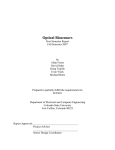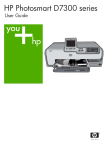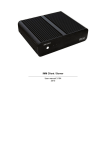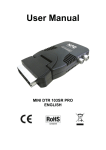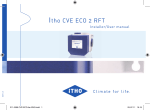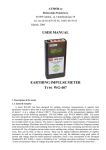Download Click Here to Your PDF Now
Transcript
POWER GRID COLLAPSE GUIDE The solar revolution of the last two decades has made solar energy an increasingly powerful force in the energy arena. It’s time for you to join those who benefit from the fantastic power of the sun. Extreme Family Survival presents you the best step by step guide you can get to generate your own electricity by using solar panels. We will take to the next level in building your solar system by showing you the complete details, no cuts, no unfinished business. By now, you should be familiar with all the theoretical knowledge concerning safety precautions regarding electricity, basic notions about the efficient use of energy and how the solar panels actually work. The SOLAR PANELS MANUAL provides all this information that you need before you start building your Solar System. Our purpose is to build 8 solar panels. Each one is made of 4 stringers and each stringer consists of 9 solar cells connected together with tabbing wire. After that, we will show you how to mount the solar panels on your roof and how to build the box which will house the batteries, the charge controller and the power inverter. After connecting all the components together, you will have the chance to see exactly how the system works. Good luck! 2 POWER GRID COLLAPSE GUIDE In this first step, we will go over all the tools and materials that you will need for the solar project. You will have a separate file with these as well. The solar panel will be constructed based on a polycarbonate back side and a regular 4 mm glass for the front side. The Glass is already cut to size : 126 x 56 cm. The Jig Saw will be used to cut the polycarbonate. A drill and some drill bits will be used to make wholes for the J-box, where the connection between panels will be made. The silicone will seal the solar panel and glue the frame together. To prevent the oil from your hands from staining the cells and reducing the amperage output, you will use gloves. The protecting eyewear will protect your eyes while soldering or steel cutting. The soldering gun is used to solder the cells together. Sticky paper will be used to keep the solar cells glued to glass. Sponge Flooring will be placed between cells and the back side of the panel. You also need a multi meter that can measure both volts and amps. 3 POWER GRID COLLAPSE GUIDE A pencil or a marker and a 45 degree marker tool, whitch you will use to be sure that you get 90 and 45 degree corners are also important tools. The measuring tape will help you get the right measurements. The most important part of a solar panel are the individual solar cells. The cells are what turn the sun energy into usable DC power which we will then convert into AC power. We are using 12.5 cm by 12.5 cm cells. You can purchase pre-tabbed cells which cost a little bit more, but we will use untabbed cells, so you can see how to join each of these together with tabbing wire. The buss wire will be used to connect the cells at the end of the strings, whitch will be connected to the wires that exit the panel. For exit wires you can use 3 amps wires. You will need a junction box, also called a “J box” where the exit wires will be placed and some connectors to put at the end of the exit wires, in order to easily connect other panels or the wires that go to the charge controller. Stainless steel screws and a wrench or socket wrench to tight the screws are also necessary. We are using 2 by 2 cm „U” aluminum profile to put a frame together and protect the cells. To mount the panels on the roof, we used 4 by 3 cm rectangular pipe and self drilling screws. To seal the holes that I drill in the roof, we will use a black silicone based on bitumen. 4 POWER GRID COLLAPSE GUIDE Before starting to work with the solar cells we need to draw a pattern for our strings. We will need a sheet of paper for that. This will help us to create straight rows and to keep the space equal between cells. First measure the width of your solar cells and make a mark. Now start measuring the height of your solar cells and leave 0.5 cm between each cell. Remember that we are using 12.5 by 12.5 cm solar cells for this project. After making all the marks, start connecting the dots together to create your pattern. The strings will have 9 cells each, but our sheet of paper is not big enough and we have room to draw just 7 cells. That’s not a problem, because we will move the strings up when we get to solder the last two cells. Draw the rest of the lines to finish this pattern. 5 POWER GRID COLLAPSE GUIDE It’s time to solder the tabbing wire to the PV cells. In order to do that, it’s best you place the sheet of glass on top. This is a perfect surface to solder the solar cells without breaking them. Now you can put the gloves on and start working. We are using untabbed solar cells which are less expensive than the tabbed ones. It will take some time to do that, but it’s the perfect opportunity to show you how to tab solar cells. Before soldering the tabbing wire, remember to use the flux pen to clean the contacts of the solar cells. To get the flux flowing, you need to press a couple of times until the tip of the pen starts to turn yellow. As you may already know, the top of the solar cell is negative and the other side is positive. We will talk more about that when we will start soldering the cells together, but now we need to solder the tabbing wire on each cell. We will start cutting the tabbing wire, but first we need to measure it. The length of the tabbing wire should be twice the height of the solar cell. Since we are using 12.5 cm solar cells, the length of the tabbing wire should be around 25 cm. Make a bundle of wire bent on 25 cm and when you make a cut on both ends, you will have more wires ready to be soldered on your solar cells. Try to make the tabbing wire straight as possible to align it properly with the contact of the solar cell. After the tabbing wire is aligned, you can start moving the soldering gun from one end to another. Do the same thing for the rest of the cells. Consider wearing a mask, because the fumes from the soldering may give you headaches. 6 POWER GRID COLLAPSE GUIDE All the cells are tabbed right now and we can start soldering them together to create 4 strings of 9 cells each. Lay the cell with the face down and start applying the flux to clear the contacts. The solar cells will be soldered in series, so the negative wire of the second cell will be soldered with the positive contacts of the first cell. The cells should be aligned properly to match the pattern. We will solder both wires at the bottom to make sure that the distance between them will stay the same. Now we can start soldering the rest of the tabbing wire applying heat with the soldering gun. If the tabbing wire is too long, just bend the excess and it can be cut using the scissors. Make the same thing with the rest of the cells until you get 9 solar cells in a row. Apply flux on the second cell and align the next one. As mentioned before, our paper sheet is too small and we were able to draw just 7 cells. We will move the string up in order to solder the rest of two cells to complete this string. Don’t forget to apply flux, it’s very difficult to solder the wires on the contacts if you don’t apply it. At the last cell from every string you need to solder the exit wires. We already cut two pieces of tabbing wire 17 cm long. Apply flux and solder the wires in place. In this way we will have the positive side on this end and the negative side on the other end of this string. Remember, the front of cell is negative and the back positive. We will do the same thing with the other three rows. After the strings are completed, we will remove them from the glass and using a cleaning solution we will make sure that the glass is clean and clear before going to the next step. 7 POWER GRID COLLAPSE GUIDE The strings will be soldered in series in order to get around 20 volts from our solar panel, enough to charge a 12 volt battery. To connect the strings easier, the first string should be with the negative side on the top of the panel and the positive side on the other end. The second string should be arranged opposite the first row. rd The 3 string will be arranged like the first one. To st rd make things easier, keep in mind that the 1 and 3 string need to be arranged in the nd th same way and the 2 and 4 string need to be in the opposite way. Now, it’s time to connect the strings together. We will measure 2.5 cm from the margins to make sure that there will be enough room for the aluminum frame. The width of the profile is 2 cm and we will leave a space equal with 0.5 cm from the frame to the string. Between each string we will have around 0.5 cm because in this way the solar panel will look very nice and compact. At the bottom, the first two strings will be connected together using the buss ribbon, the wider buss wire. We will measure the length between the first and the last tabbing wire and cut a piece long enough to connect these two strings together. Using the scissors, the excess of tabbing wire from the exit wires will be removed. The strings 3 and 4 should be connected in the same way. Next, we want to solder the exit wires for this solar panel. We are using a piece of buss ribbon about 13 cm long for this step. We will leave the end that’s inside longer, in order to connect the wires that will exit the case th of our solar panel. We will do the same thing for the 4 string as well. One string will represent the negative side of our panel and the other will represent the positive side. Now it’s time to connect the strings 2 and 3 together. The solar panel shoul produce 19.5 volts and around 4.5 Amps, that’s a total of 87.75 Watts. 8 POWER GRID COLLAPSE GUIDE We will start applying the sticker over the solar cells. This will stick to the glass and will keep the solar cells secured in place. We have already cut it to size. We’ve left around 3 centimeters on each side to overlap it on margins. We found an easy way to apply the sticker. The glass should be about 5 cm off the table to paste the sticker 2 cm on the face of the panel. After that put the glass back on the table to keep that area pressed down when you will start pasting the rest of the sticker over the solar cells. When the sticker is applied on the solar cell, there’s no turning back, don’t try to unpaste it if you’ve made a mistake because the cell will crack and you can ruin the entire project. It’s a good idea to have a friend assisting you when you are doing this step. If the sticker has been folded in some places, don’t worry because it won’t affect your solar panel and will not be visible after the solar panel is completed. Take your time and don’t rush when you are doing this process. Make two cuts to get the exit wires. Now, press gently to make sure that the sticker is pasted everywhere. We will make a cut on each corner to overlap the sticker. 9 POWER GRID COLLAPSE GUIDE Before we continue, we will test now and see which side is the positive side. If it’s showing a “Minus” on the multimeter, the leads are inversed. In this case, where we have the black lead is the positive side of the panel and the wire where we placed the red lead is the negative side. Then we will inverse the leads and try again. Now we can solder the wire which will exit the panel’s case. We are using a 2 amps wire for this process. We will peel off the ends of each wire and then apply some solder. This way it will be much easier to solder the exit wires to the buss wires. We will apply some solder on the buss wire as well. Put something under the buss wire when you start soldering the pieces together. We used the blue wire for the positive side and the brown one for the negative side. We will do this thing for all of the solar panels in order to connect them easily when we get to that step. 10 POWER GRID COLLAPSE GUIDE It’s time to start working on the aluminum frame which will hold our solar panel together. We will start by measuring the height of the solar panel. The glass is 126 cm by 56 cm. We will add one centimeter to our measurements. So, we will have one aluminum piece of 127 cm for each side of the solar panel and another two for top and bottom which will measure 57 cm. We are using this template to mark a 45 degrees cut. We will use the saw blade to mark the cut and then we will use the angle grinder to complete it. Then we will file the edges to make them look right. We will mark and cut the other end as well. We have the other three sides left now. We will do the same process to finish them. Keep in mind, add one centimeter on your measurements when you are building the frame. When you are securing the aluminum profile in the vice, make sure the cut will be made close as possible to the vice, in order to eliminate the vibrations. After all the pieces are ready, you can start assembling the frame for this solar panel. Put the frame in place to see how the corners are aligning. 11 POWER GRID COLLAPSE GUIDE The polycarbonate sheet will have the same dimensions as the glass sheet used for the front of the panel, 126 by 56 cm. We will mark two points and using a piece of profile we will draw a line. To easily cut the polycarbonate we will use the jigsaw. Between the cells and the polycarbonate we will place this sponge used on laminate flooring. This will absorb any shocks our panel may have during his life time. This will also have the dimensions of the glass sheet, 126 by 56 cm. After the sponge is in place, we will make a hole to get the wire through and then we will place the polycarbonate sheet on top. But before that, we need to remove the protection film from both sides. We will drill a hole to get the exit wire. The J-box will be mounted on the back of the panel. Inside it, we will make the connections between the other panels in order to keep the water out. The J-box will be kept in place by two screws. We will make a mark and drill the holes in polycarbonate. Now, insert the screws which will secure the J-box in place. If the holes of the j-box are too small and the screws won’t fit, use the drill and a drill bit to make them bigger. The screws are now in place and we can tight the nuts and finish the job. The polycarbonate needs to go under the aluminum frame. You can start applying the silicone to seal the solar panel and make sure that water won’t go inside. It will also keep the aluminum profile in place. After the silicone dries up, you will see that your panel is very rigid and everything is ok. Flip the panel and apply silicone on the other side as well. Make sure that all the cracks are filled. The solar panel will be ready to use after the silicone is dried. We will build the rest of 7 solar panels just like we built this one. 12 POWER GRID COLLAPSE GUIDE Now we can go outside and start mounting the aluminum profile which will help us to secure the panels on the roof. First make marks to make sure that the aluminum bar will be mounted straight. We are using a 4 by 3 cm aluminum rectangular pipe for this step. We will make marks where the holes will be made. We mark the place for each solar panel to make an idea where we should drill the holes for screws. Try to put the screws between solar panels so it won’t push them up. This is one option of mounting these bars. Another option will be to make the first hole in the aluminum bar bigger, to get the screw inside the bar. In this way it won’t stick out to push the solar panels up. We will show you on later how this works, but now try this first option. I think the second option is much easier, since you don’t have to measure exactly where the screws will be, but we will still show you both options. We have marked the place for each hole and now we will start drilling them. Before we mount the rectangular bar on the roof, we need to put some roof silicone on each hole. We will use self drilling screws to keep the profile in place. It’s a good idea to consult with your roof designer to tell you which kind of silicone you should use to make sure that you won’t have any problems. 13 POWER GRID COLLAPSE GUIDE Now we can mount the bar on the roof. The self drilling screws should be long enough to go through the rectangular pipe and also drill into your roof securing the aluminum profile in place. We will mark the bar which will go parallel with the profile already mounted. We are making the same marks because we want to have the screws which will secure the profile in the same place. Again we will apply silicone on each hole to make sure that there won’t be any licks. We will measure and mark the place where the second profile will be mounted. We will then measure again to make sure that the panels will be mounted between these screws. We will mount the rest of them like we mounted these two bars. We are now on the last two sections. After that we will show you how to build a box to house the batteries, charge controller and the power inverter. This is how the rectangular bar should look on your roof after this step is completed. 14 POWER GRID COLLAPSE GUIDE Now we will show you how to build the box which will house the batteries, the charge controller and the power inverter. We are using steel profile which is used on false walls or false ceilings. This profile is used to keep the plasterboard in place. The dimensions of this box will be 80 x 40 x 30 cm. We measured the batteries that we will use in order to make sure that they will fit nice inside. If you will use bigger batteries, you may consider building a bigger box. We will measure and using the scissors we will make two cuts then bend the profile in order to cut it straight and easy. We need four 80 cm bars for the length of my box, 4 which will represent the width (40 cm) and another 4 that will have 30 cm, which will be the height. After cutting all the pieces, we can start assembling the pieces together. We will start by creating one side of the box. Using a plier we will bend inside the edges of the profile so the other piece will fit well inside. Using a t-square, we will make sure that we have a 90 degrees angle. To keep the pieces together, we are using small self drilling screws. Make sure you check again to see if everything is ok. After the second screw is inserted, you won’t be able to move the pieces anymore to make any adjustments. When the first side of the box is ready, we can start the work on the second one. Again, bend the margin inside to make room for the other piece. We will try to make the end of this piece straight because we can’t use the t-square to see if everything is aligning well. We will then start inserting the self drilling screws to fix both pieces together. 15 POWER GRID COLLAPSE GUIDE Do the same thing on the other side. After both sides are ready, we can connect them together. We will cut 7 centimeters from both sides. Then we will make marks on the other pieces and we will start cutting them. After we have cut all the pieces, we can start fixing them in place. The margin should be bent as well like on the other pieces to make sure that it will align properly. Using the t-square, make sure that you have a nice 90 degree angle and start inserting the screws. You need to check again to see if the angle is right when you insert the screws on the other side. Fix the other pieces in place like you did with the first one. We’ve found a way to keep the profile in place using this hand vice. If you don’t have one and you don’t want to buy it, you can ask a friend to keep that in place for you until you insert the first screw. It’s time to fix the last piece in place. We will insert a screw on each corner and after this side is aligned properly we will insert the rest of the screws. We will insert a screw on the side to keep the frame in place because it can be hard sometimes to tight the hand vice with one hand. We’ll do the same thing with the other two corners. Now we can insert more screws because all the pieces are aligned. We will now measure the frame to know the dimensions for the polycarbonate sheet. It’s best you use the jigsaw to cut the polycarbonate sheet. We will remove the protecting film from both sides. It’s a good idea to mark the pieces and the place where should be mounted if you want to cut the polycarbonate first, then fix it in place. We will mark and cut the other piece of polycarbonate as well. You can mount the pieces which are already cut and then do the measurements. We will apply silicone to make sure that water will stay out of this box, because it’s not a good idea to have that around our batteries, charge controller or the power inverter. The 16 POWER GRID COLLAPSE GUIDE charge controller and the inverter are sensitive pieces and they don’t tolerate water on their circuit boards. We will insert some self drilling screws to keep the polycarbonate in place. Now we can overlap this section and make the marks to do the cutting. Leave some space on both sides. This way you will get nice looking corners. Apply silicone, then put the polycarbonate in place and start inserting the screws to secure it. We will proceed to cover up the rest of the sides as well. We want to make the top side to act like a lid, so we will mount two hinges on that. We will put the hinges in place and we will mark where we should make the holes. Now it’s time to fix them in place using popping rivets. The first hinge is fixed in place. We will mount the second one as well. We want to make the marks for the holes we need to drill in the lid. Using popping rivets we will fix the lid in place now. We will use a self adhensive door sealing gasket to make sure that water will stay out of the box when the lid is closed. We will measure and cut this to size the sealing gasket and then remove the layer which covers the glue. After that, it’s ready to be applied. We will do the same thing on the rest of margins. Now, we are drilling a hole for a screw which will keep the lid closed. We will make a mark and drill a hole in the polycarbonate as well. We will tight the nut and the lid should stay closed now. The bolt that we are using is a bit too long. We will make a cut using the angle grinder to make it smaller. You can put a screw on the other two margins as well to make sure that your box will stay sealed and the water won’t go inside. We will leave it like that for now because we want to go outside to install the solar panels, then connect everything together to test our system. 17 POWER GRID COLLAPSE GUIDE But first, we want to show you quickly the second option you have to fix the rectangular aluminum bars on your roof. We will use this small piece to show you that. First, drill a hole on the other aluminum profiles, then using a bigger drill bit, make the top hole bigger so you can tight the bold inside of that aluminum profile. The hole is to small right now, because we are using a small drill and this is the largest drill bit that we can use with this drill, so our only option is to try and make the hole bigger with it. We need to make sure that the head used to tight the screws will also fit through that hole. Keep in mind, that only the top hole should be bigger, the other one should remain small. After the top hole is big enough, we will flip the aluminum profile and apply silicone like we did on the other aluminum pieces. We will insert the self drilling screw now. The screw is not tight enough so we will use an extension to do that. All 8 solar panels are ready now to be installed. We will connect each solar panel before we mount it in place, because there’s not enough room to get the lid of the J-box when the panel is mounted. We will peel off some of the insulation of the wire. We are using this connector which will stay in the J-box. The screws should be loose before the wires are inserted. After the wires are fully inserted, the screws will be tighten up, in this way the wires will stay in place. On the other end will be inserted the wires which will go to the next panel. We will connect the panels in parallel, so we will connect the positive leads between them. Same thing for the negative leads. In this way we will keep the same voltage but the amperage will rise. We want to test and see how many volts and amps we get from one solar panel. 18 POWER GRID COLLAPSE GUIDE Because the panel is not oriented into the sun, it’s generating 11.82 Volts. Let’s flip the panel and see what kind of results we get. Ok, now the panel is generating 19.26 volts. Let’s check the amps. It’s generating around 4.5 amps, which is very good. If we want to find out how many Watts this panel is producing, it’s simple : Volts x amps = watts. In our case, the panel is producing 86.67 Watts. The entire system should push into the batteries around 700W / hour which is not bad at all. We will insert into the J-box the wire that will go on the next panel. Make sure you connect the wire respecting the color code that you used when you built the solar panels. In our case, the blue wire is the positive lead and the brown wire is representing the negative lead. I will put the lid of the j-box back and this solar panel is ready to be mounted. 19 POWER GRID COLLAPSE GUIDE But first, we need to show you how to bend a piece of aluminum to create mounting clamps. We will cut a piece of L aluminum profile in half to get our raw material for the mounting clamps. Don’t forget to use the protecting eye glasses when you are using the angle grinder. Be careful when you handle the pieces because they are very hot. We will file the edges a bit to make them look good. The frame width of our solar panels is two centimeters. So we will measure 2 cm and make a mark on the aluminum piece. We will secure the piece in the vice and bend it where we’ve made the mark. Next, we will mark 1.5 cm and bend the piece again. It will be much harder to bend the piece now, so the best option is to use two hammers. The final piece should look like a Z shape. We will need one more piece for the first solar panel. We will use this Z shape clamps only on the first and last solar panel, the rest of them will be secured much easily using a straight piece of aluminum 5 cm long, with one hole in the middle. These two pieces are almost ready. We need to drill a hole for the self drilling screw. Let’s go outside and mount the first solar panel. Ask a friend to keep the panel in place until you insert the first screw. Be careful when you are trying to insert the self drilling screw, because the aluminum clamp tends to start spinning. 20 POWER GRID COLLAPSE GUIDE We’ve found that the best way of inserting the self drilling screws is to drill a small pilot hole first. This way the screw will penetrate the aluminum profile much faster. We will use the level to make sure the first solar panel is mounted straight. It’s looking ok, so we can drill the pilot hole and then secure in place the other clamp. We will move forward and connect the next solar panel. Same thing, we will use a connector, the negative and positive leads will be connected together and secured in place. Don’t forget to insert the cable into the J-box first and then twist the wires. After both solar panels are connected together in parallel, we can connect the wire which will go to the next panel. To secure the panel in place, we will use a straight piece of aluminum which is 5 cm long. We drilled a hole in the middle to insert the self drilling screw. We will drill the pilot holes first and then we will secure the panels using these two pieces. We will repeat this process with the rest of the solar panels. The panels will be connected in two sets of 4. Right now the energy is flowing through the wire that is coming from the other two panels, but it’s nothing dangerous because the voltage and amperage is very low. th After the 4 panel is connected, we will get the exit wire and then we will start connecting the other 4 panels together. We don’t want more than 16 amps flowing through an exit cable. You will see in a moment how we plan to connect two separate sets of panels. th This is the 4 panel, so pay attention! 21 POWER GRID COLLAPSE GUIDE We will do the same thing, connecting the other three panels in parallel with this one. But the cable which will exit this panel will not be connected to the th 5 panel. It will represent the exit wire of this set of 4 panels. We can fix in place this solar panel now. Here you can see the wire that’s coming from these 4 solar panels. We will put some electrical tape to make sure the panels are not in a short circuit. After that, we will start mounting the rest of the solar panels. We will cut the wire of this solar panel because it’s a bit too long and after that we will make the connections like we did on the other panels. We will insert the exit wire of the second set of solar panels. So we will have both wires close to each other. After these two wires are twisted together and secured inside the connector, we will add another cable which will go to the next panel. We will leave around 1 meter of cable, we will cut and insulate the wires. This is the cable which will go to the next solar panel. It’s time to connect the rest of three solar panels to complete the roof installation process. We will connect the last solar panel and then we will show you how to connect the charge controller to the batteries, how to connect two batteries together, how to connect the power inverter and after these things are in place, we will be able to finally connect the solar panels to the charge controller and start charging the batteries. Here we will use the Z shape mounting clamps that we have created. We will try to bend this piece using the plier to make it look better. This is how the solar panels should look on the roof. Make sure you are mounting them straight so it will look nice when you look from the ground. The mounting system is very easy and you can make adjustments if you want to move the solar panels up or down. In the middle you can actually see both exit wires. 22 POWER GRID COLLAPSE GUIDE We will drill a hole into the box that will hold the batteries and we will insert a cable through that. We will make a node to make sure the wire will not be pulled out through the hole we’ve made after it’s connected to the charge controller. It’s time to connect this wire to the charge controller, before connecting it to both sets of panels. It’s a good idea to have the system ready to receive electricity first and then connect the energy source, in our case the solar panels. We will connect the wires on the charge controller on the “power input” connections. Now, we will connect the wires which will exit the charge controller and go on my batteries. We are using a 5 amps cable for this job. We will peel off some of the insulation and twist the wires to make them fit inside the charge controller. The wires should be inserted into the charge controller connection ports. We will keep the same color code, blue for positive and brown – negative. We want to secure the charge controller in place using two self drilling screws. Now, we can connect the charge controller to the batteries. Those are the battery terminals that we will use for this project. 23 POWER GRID COLLAPSE GUIDE And these two are the cables which will go to the second battery. Make sure that all the connections are well made because if you have a loose connection, the terminal can spark or begin to kindle. Using these two wires, we will connect the power inverter to the batteries as well. We will start the inverter to make sure that everything is working right. The green led is On, so it should generate electricity right now. We will connect the second battery now. The batteries will be connected in parallel to keep the voltage down. The solar panels are generating around 19 volts, so it’s perfect to charge 12 volts batteries. The charge controller, the inverter and the batteries are now connected together and we can connect the solar panels to close the circuit and start charging the batteries. If your panels are mounted on your roof, you can get both exit wires and make the connection in a J-box, or inside your battery storage box. Just make sure the water won’t mess around with your connections. 24 POWER GRID COLLAPSE GUIDE We want to check and see how much power the first 4 solar panels are generating. The voltage is 19.6 . We will check the amps now. We get over 16.5 amps, which is very good for this weather. The amps may fluctuate during the day, if it’s a cloudy day or if there’s a cloud blocking the sun’s light, you may see a drop in the amperage. The first set of 4 panels were generating 19.6 volts and 16.5 amps. Now a cloud is blocking the direct light of the sun and you will see how much amps we will get. We have 11 amps, but it’s more than enough to charge the batteries. We will check the voltage now to make sure that this set of solar panels is working right. After that, we can connect the wires together and get the power into the charge controller. Remember to connect the panels in parallel so the only thing you will do is to build more amps and keep the voltage the same. We will apply electrical tape to insulate the connections. If you want, you can use the same type of connectors that we used on the solar panels. But we are out of connectors so we will twist the wires together and apply electrical tape. Here you can see the green light. That means power entering into the charge controller. The red light on the batteries means that they should be charged.You may use a different charge controller, so make sure that you will read the user’s manual. We will open the power inverter and make a small test and see if our system is working properly. We have this TV that we will open using the power of the sun. You can see it open. The screen is displaying a “no signal” image with those gray dots, but because it’s a CRT TV and not an LCD, it’s not showing right on camera, but you can see it running, that’s all that matters. We will open it again and we will show you that it stops when we pull the plug. That’s all. We hope you enjoyed this project and we hope you will have fun building it. 25

























